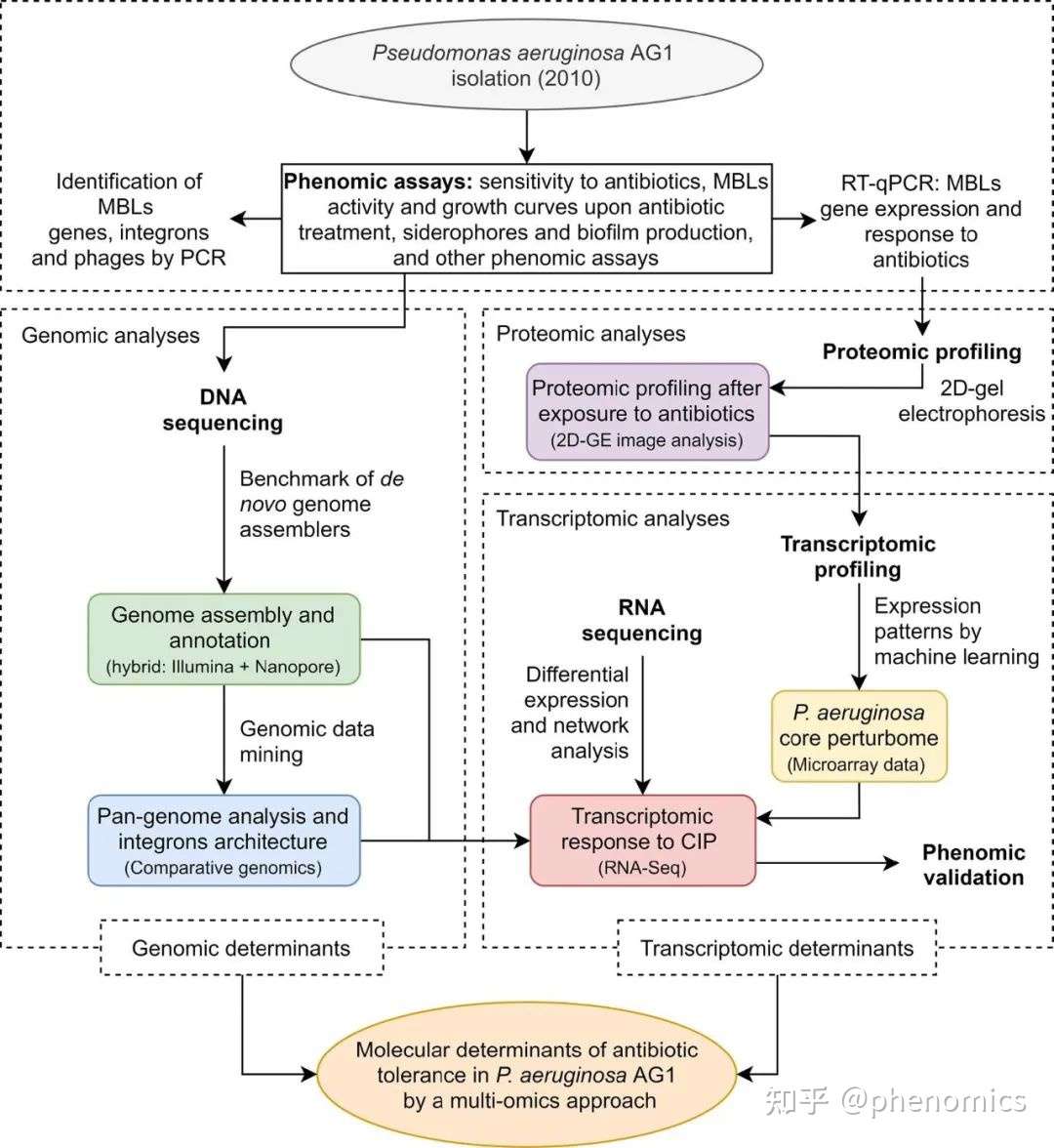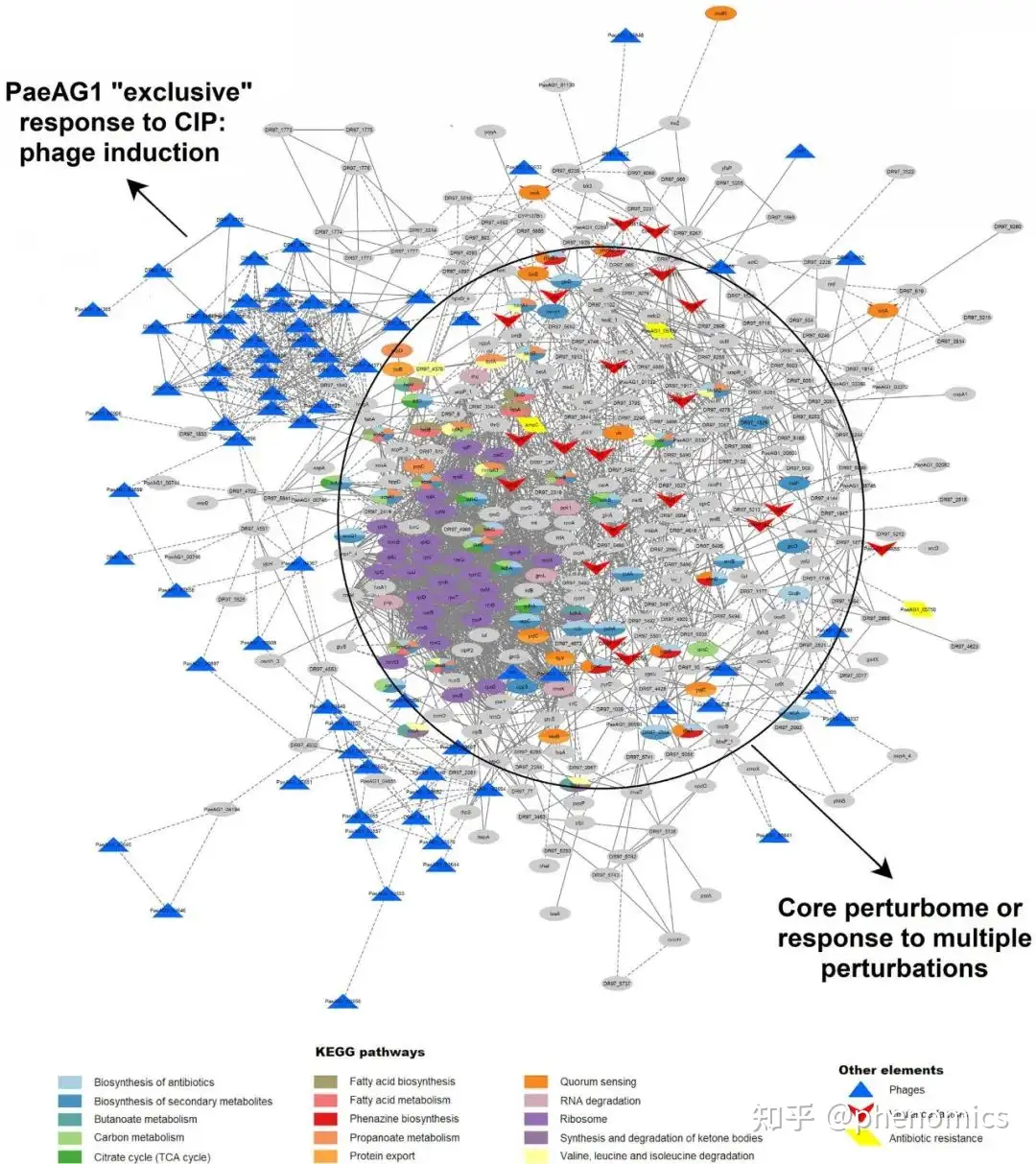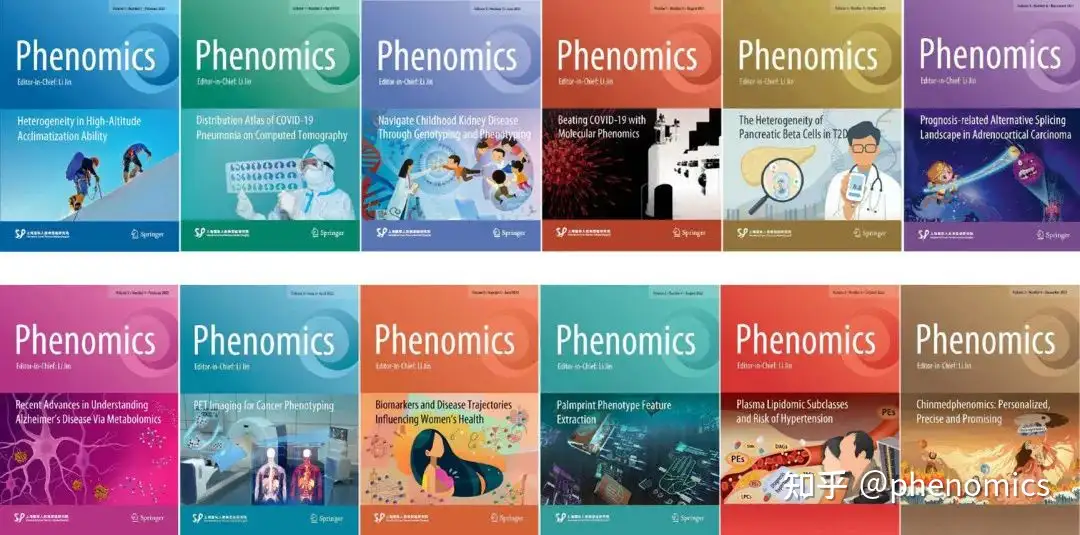博文
Phenomics| 跨越十年研究的综述:通过多组学方法研究PaeAG1抗生素耐受性的分子决定机制
|
近日,《表型组学》(Phenomics)期刊在线发表哥斯达黎加大学Fernando García课题组题为Molecular Determinants of Antibiotic Resistance in the Costa Rican Pseudomonas aeruginosa AG1 by a Multi-omics Approach: A Review of 10 Years of Study的综述文章。
由于抗生素耐药性会影响治疗效果,长期以来被认为是威胁公共卫生的重要因素之一。由哥斯达黎加科学家分离发现的菌株铜绿假单胞菌AG1(PaeAG1)对于多种抗生素如β-内酰胺类(包括碳青霉烯类)、氨基糖苷类和氟喹诺酮类都具有抗性。PaeAG1是研究发现的第一个同时携带VIM-2和IMP-18基因编码的金属β-内酰胺酶(MBL)的绿脓杆菌分离物。
PaeAG1具有重要的碳青霉素抗性,被世界卫生组织(WHO)列入耐药菌优先性列表的优先1级(Priority 1)。PaeAG1在基因组和表型组水平上具有抗药性特征,Fernando García课题组使用多组学方法开展了长达十年的PaeAG1抗药性分子机理研究。
论文DOI链接:
https://link.springer.com/article/10.1007/s43657-021-00016-z

图一 PaeAG1抗生素耐受性的分子决定机制研究工作图
Fernando García课题组首先通过基因组组装分析ST-111高危PaeAG1菌株的基因组结构,并从13种不同方法里选取了最佳组装方式,发现PaeAG1基因组有57个基因组岛,包括6个原噬菌体和2个完整的带有MBLs基因的整合子。此外,它有250个基因预计与其毒性有关,有60个基因与抗药性有关。
接着,Fernando García课题组通过比较基因组学方法研究了铜绿假单胞菌基因组的系统进化、基因组岛在其它菌株的情况,以及携带MBL整合子的基因组结构。其中,IMP-18整合子和其基因组结构之前尚未被报道过。
基于双向电泳图像分析和机器学习方法,研究了暴露于抗生素后的PaeAG1蛋白质组图谱。结果显示,较于其它抗生素富集情况,环丙沙星处理组与对照组(LB培养基,不含抗生素)类似。他们通过机器学习方法研究了铜绿假单胞菌在多种暴露干扰下的主要反应,基于公共转录组数据评估了排列和选择基因的6种方法。其中,46个核心反应基因的分子注释表明其生物功能与DNA损伤修复、代谢和抗逆性相关的有氧呼吸有关。

图二 PaeAG1在环丙沙星处理后的转录网络
为了评估环丙沙星对PaeAG1的影响,Fernando García课题组进行了生长曲线对比,基于RNA-Seq的差异表达分析和网络分析。据观察,生长曲线速率随着环丙沙星浓度增加而降低。转录组分析显示有518个基因在环丙沙星处理后呈现差异性表达,包括表达上调的噬菌体基因,并通过菌斑分析在表型层面进行了验证,进而解释了生长曲线速率的降低。
因此,Fernando García课题组使用多组学方法(基因组、比较基因组、转录组、蛋白质组和表型组)为PaeAG1抗生素耐受性相关的基因组和转录组研究提供了全新视角,探究了该菌株的高风险状况和抗性特征,并期望未来通过更多研究工作为病原体防治策略和人类健康做出贡献。
Molecular Determinants of Antibiotic Resistance in the Costa Rican Pseudomonas aeruginosa AG1 by a Multi-omics Approach: A Review of 10 Years of Study
Abstract:
Pseudomonas aeruginosa AG1 (PaeAG1) is a Costa Rican strain that was isolated in 2010 in a major Hospital. This strain has resistance to multiple antibiotics such as β-lactams (including carbapenems), aminoglycosides, and fluoroquinolones. PaeAG1 is considered critical (Priority 1) due to its resistance to carbapenems, and it was the first report of a P. aeruginosa isolate carrying both VIM-2 and IMP-18 genes encoding for metallo-β-lactamases (MBL) enzymes (both with carbapenemase activity). Owing to these traits, we have studied this model for 10 years using diverse approaches including multi-omics. In this review, we summarize the main points of the different steps that we have studied in PaeAG1: preliminary analyses of this strain at the genomic and phenomic levels revealed that this microorganism has particular features of antibiotic resistance. In the multi-omics approach, the genome assembly was the initial step to identify the genomic determinants of this strain, including virulence factors, antibiotic resistance genes, as well as a complex accessory genome. Second, a comparative genomic approach was implemented to define and update the phylogenetic relationship among complete P. aeruginosa genomes, the genomic island content in other strains, and the architecture of the two MBL-carrying integrons. Third, the proteomic profile of PaeAG1 was studied after exposure to antibiotics using 2-dimensional gel electrophoresis (2D-GE). Fourth, to study the central response to multiple perturbations in P. aeruginosa, i.e., the core perturbome, a machine learning approach was used. The analysis revealed biological functions and determinants that are shared by different disturbances. Finally, to evaluate the effects of ciprofloxacin (CIP) on PaeAG1, a growth curve comparison, differential expression analysis (RNA-Seq), and network analysis were performed. Using the results of the core perturbome (pathways that also were found in this perturbation with CIP), it was possible to identify the “exclusive” response and determinants of PaeAG1 after exposure to CIP. Altogether, after a decade of study using a multi-omics approach (at genomics, comparative genomics, perturbomics, transcriptomics, proteomics, and phenomics levels), we have provided new insights about the genomic and transcriptomic determinants associated with antibiotic resistance in PaeAG1. These results not only partially explain the high-risk condition of this strain that enables it to conquer nosocomial environments and its multi-resistance profile, but also this information may eventually be used as part of the strategies to fight this pathogen.
▉ 论文作者简介:
Fernando García Santamaría教授

哥斯达黎加大学副校长、国际人类表型组研究协作组(IHPC)理事会成员,于德国维尔茨堡大学遗传学和微生物研究所获得博士学位,研究工作重点是抗生素耐药性,荣获Florida Ice & Farm创新及卓越奖。主要研究成果包括发现了具有高耐碳青霉烯类性的携带bla IMP-18和bla VIM-2金属-β-内酰胺酶基因的铜绿假单胞菌AG1;通过沉积物微生物群落的生理特征,展示了抗生素诱导的热带农业生态系统的耐受性发展;确定了在哥斯达黎加水稻作物中伯克霍尔德氏菌的存在;发现了哥斯达黎加饮用水中幽门螺杆菌及其与当地胃癌发病率的关系;鉴定了哥斯达黎加灌溉地区用于集约作物、牲畜和水产养殖的抗生素的危害优先级和风险特征等。
Phenomics期刊简介

Phenomics是一本新创的同行评审国际期刊,聚焦表型组学前沿研究,搭建全球表型组学领域专家交流的国际平台,推动该领域相关的理论创新和学科发展。
本期刊拥有强大的国际编委团队,复旦大学金力院士担任主编,美国系统生物学研究所Leroy Hood院士、澳大利亚莫道克大学Jeremy Nicholson院士、德国莱布尼兹环境医学研究所Jean Krutmann院士、复旦大学唐惠儒教授共同担任副主编,复旦大学丁琛教授担任执行主编,另有来自全球多国的三十多位著名科学家共同组成编委团队,以及四十多位青年科学家组成青年编委团队。
我们诚挚地邀请广大科研人员投稿!
Phenomics官网:https://www.springer.com/journal/43657
投稿链接:https://www.editorialmanager.com/pnmc/
编辑部邮箱:phenomics@ihup.org.cn、phenomics@fudan.edu.cn
欢迎关注Phenomics官方公众号

文章来源:人类表型组计划公众号
https://blog.sciencenet.cn/blog-3558836-1387589.html
上一篇:Phenomics| 是自然选择还是中性理论?分子进化里的新型遗传漂移,作为个体间突变的随机渗透率
下一篇:Phenomics| 重磅!Jeremy Nicholson院士解读分子表型组学在新冠肺炎研究中的重要作用